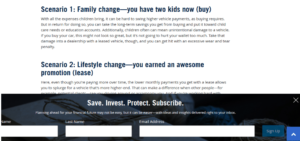Financial institutions have recently stepped into the social media game more dynamically, realizing they can reach more customers and generate leads through social media marketing.
However, many financial firms are still stumped. They are not sure how much to invest time in it, how to best utilize it and if their resources and efforts are worthwhile. The biggest challenge is estimating the social media ROI.
What is Social Media ROI?
Social media ROI (“return on investment”) is a measure used to signify the return from the cost of investment in social media.
The cost of investment includes factors like human resources, time and money.
For instance, let’s assume the marketing department in a financial firm has 4 employees. If each one of these employees has an average salary of $80,000 a year, the cost adds up to $320,000. If, by estimation, they spend 20% of their time working on social media, that works out to $64,000 (20% X $320,000/year).
We still need to add the amount of money that will be spent on advertising, which could be $120,000 a year. That would make the “cost of investment” into social media for that firm amount to $184,000 ($120,000+$64,000) per year.
On the other hand, the returns can be calculated not only in terms of gross revenue, but also in terms of brand awareness and reputation, customer satisfaction, generating leads, new followers and subscribers, website traffic and others.
For an insurance company for example, this can mean how many users are visiting the company website and engaging with its content, which ones are signing up and eventually how many contact an agent or purchase a product or service.
Why Track Social Media ROI?
Mindlessly posting on social media without a specific plan is a waste of time. Tracking the ROI of a social media campaign can show you what is working for your company and what isn’t. More specifically, you will be able to see if you are reaching your goals and if the platforms you are using are benefiting you. Additionally, you can examine which areas need improvement and which campaigns are leading to conversions.
Getting Started
First, figure out what your company’s goals are. Are you aiming at raising brand awareness and building trust? Rewarding customer loyalty? Do you want your campaigns to result in sales?
When coming up with specific goals, consider the following aspects: Awareness, Engagement and Acquisition. Let’s take a look at each one.
1. Tracking brand awareness
In order to start tracking and measuring brand awareness, you need to use tracking tools like Google Analytics. Here, you should focus on analyzing three points.
- Reach. Number of users who see your content (e.g. post, ad, etc.)
- CTR (Click-through rate). The ratio of users who click on one of your links in relation to the total viewers who see the link. For instance, this means if you have 100 impressions for a specific post and 10 clicks for that post, your CTR is 10%.
- Bounce rate. The percentage of users who view only one page on your website and quickly leave.
Keep in mind that your reach can be determined by how many followers and fans you have (or new ones you acquire), but that number means nothing if you don’t examine it in connection with your CTR and bounce rate.
For instance, if your post reaches 1000 users and your CTR is 3%, only 30 users engaged with it. If you add a bounce rate of 80% or 90%, then you know something isn’t working, since the users aren’t staying engaged.
One way you can spread brand awareness is by sharing your expertise and knowledge. Freddie Mac takes advantages of this strategy to target prospective homeowners with content that they will find valuable.
2. Tracking customer engagement
Your next goal can be to get users to interact with your brand online, ask questions, give feedback or sign up for your email list.
For instance, one of your goals can be getting users to sign up for a newsletter. You can use Google Analytics to track key performance indicators (KPIs) like clicks and website traffic, and see which campaigns are helping you accomplish this goal in order to continue investing in them.
Additionally, you can set up a goal funnel and get a visualization of the pages that users are accessing on your website. This helps you determine where users are stepping out of the conversions process so that you can plug any leaks and improve your process.
Prudential provides valuable content for its fans and followers. By clicking on the post, users are redirected to Prudential’s website and after skimming the article they are encouraged to sign up for more email updates on financial services (see images).

The Facebook post encourages you to click through

The post has a CTA designed to get you to sign up for the Prudential email newsletter
You can start measuring returns on examples like the one above if you work with the sales department in your firm. If you have estimated that 20% of the users who subscribe to the newsletter end up requesting your services, then you can measure more specific ROI numbers.
3. Tracking customer acquisition
The final and most desired step is acquiring new customers. Here, tracking ROI is simpler because the new leads become paying customers. We can estimate the gross revenue from acquisitions by taking into account the total lifetime value of the customers (CLV) and multiplying it with the number of customers acquired through social media.
If you have an insurance company whose total customer lifetime value (e.g. for a span of 5 years) is $2,500 and you have acquired 20 new customers from your campaign, then the estimated gross revenue is $50,000 ($2,500×20). If we want to calculate the social media ROI of the campaign that generated those specific customers, all we need to do is consider the cost of the campaign (e.g. $10,000) and use the social media ROI formula.
An example of an ad campaign that can be measured this way is this one by the Bank of America. It uses paid ads on Facebook to target college students and offers a monthly maintenance fee waiver when they open a bank account as an incentive.
Tracking Social Media ROI
Tracking your social media ROI can show you what’s working and what isn’t. This can help you invest more into the sources yielding the greatest return.
Using all of the above techniques can improve your social media strategy and help you get the most out of each campaign.
How do you track social ROI? Let us know in the comments!








